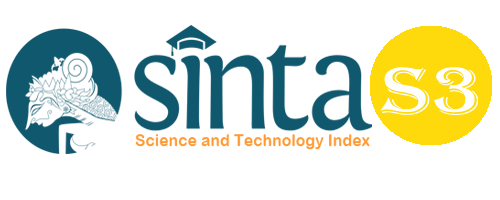Optimizing the Preservation of Fresh Tomatoes into Tomato Dates to Increase the Shelf Life of Vegetable Food
Abstract
Tomato is currently one of the high economic value horticultural commodities and still requires serious treatment, especially in terms of increasing the yield and growth of tomatoes. This research will be carried out by Hospitality Laboratory in STIEPARI Semarang. The material used is tomato and sugar. The method used is making tomato dates, observing the deterioration kinetics of tomato candied quality, estimating shelf life of tomato sweets and adding sugar. The results of this study indicate that preservation of fresh tomatoes into tomato dates to increase the storability of plant foods (P <0.05). Vegetable food has a high fiber content so that the physical properties of plant foods, so that with a preservation system using sugar can increase the shelf life of vegetable products. Research result Based on the organoleptic results (color) of tomato dates presented in the table, it shows that tomato dates with the addition of sugar as much as T0 (0% Tomato Dates 0% Sugar), T1 (Tomato Dates 30% Sucrose) both were still in the like category, while T2 Tomato Dates were 30% Lactose) and T3 Tomato Dates 30% Fructose) both were in the very like category. Based on the organoleptic results (aroma) of tomato dates presented in the table, it shows that tomato dates with the addition of sugar as much as T0 (0% Tomato Dates 0% Sugar), T1 (Tomato Dates 30% Sucrose) and T2 (Tomato Dates 30% Lactose) are still in the category likes, while T3 Tomato Dates 30% Fructose) is in the very like category. While at T2 (30% Lactose Tomato Dates) showed liking, and T3 Tomato Dates 30% Fructose) showed very liking. While the formula T3 Tomato Dates 30% Fructose) which shows the category of very like. namely the addition of 40gr lactose as much as 84% while the lowest lactose content was the addition of 20gr lactose as much as 20gr.
Keywords
Full Text:
PDFReferences
Azari, R., Tadmor, Y., Meir, A., Reuveni, M., Evenor, D., Nahon, S., Levin, I. (2010). Light signaling genes and their manipulation towards modulation of phytonutrient content in tomato fruits. Biotechnol. Adv. 28, 108–118.
Barcenilla, C., M. Ducic., M. Lopez., M. Prietp., Avelino. (2021). Application of lactic acid bacteria for the biopreservation of meat products: A systematic review.
Drake, M. A., P. D. Gerard, and Q. Chen. (2001). Effects of sweetener, sweetener concentration, and fruit flavor on sensory properties of soy fortified yogurt. Journal of Sensory Studies. 16(4): 393 – 405
D'Souza, C., Yuk, H.G., Khoo, G.H., Zhou, W. (2015). Application of light-emitting diodes in food production, postharvest preservation, and microbiological food safety. Compr. Rev. Food Science. F14, 719–740.
Elliott, Sharon S., et al. (2002)."Fructose, weight gain, and the insulin resistance syndrome." The American journal of clinical nutrition 76.5: 911-922
Fischer, Anders, and Jan Heinemeier. (2003)."Freshwater reservoir effect in 14 C dates of food residue on pottery." Radiocarbon 45.3: 449-466.
Fischhoff, David A., et al. (1987). "Insect tolerant transgenic tomato plants." Bio/technology 5.8 :807-813.
Gao, L., Zhao, S., Lu, X., He, N., Zhu, H., Dou, J., & Liu, W. (2018). Comparative transcriptome analysis reveals key genes potentially related to soluble sugar and organic acid accumulation in watermelon. PLOS ONE, 13(1), e0190096.
Kader, A. A., & Rolle, R. S. (2004). The role of post-harvest management in assuring the quality and safety of horticultural produce (Vol. 152). Food & Agriculture Organization.
Komarayanti, S. et al. (2018). Business of Local Fruit and Vegetables in Jember District as a Support of Food Security, Indonesia. Budapest International Research and Critics Institute-Journal (BIRCI-Journal). P. 208-224.
Leistner, Lothar. (2000). "Basic aspects of food preservation by hurdle technology." International journal of food microbiology 55.1-3. 181-186.
Mishra, B. B., Gautam, S., Chander, R., and Sharma, A. (2015). Characterization of nutritional, organoleptic and functional properties of intermediate moisture shelf stable ready-to-eat Carica papaya cubes. Food Bioscience, 10, 69–79.
Puricelli, V.J. A., M., Ortiz-Merino, R. A., Giacomobono, R., Braun-Galleani, S., Wolfe, K. H., & Morrissey, J. P. (2019). Origin of Lactose Fermentation in Kluyveromyces lactis by Interspecies Transfer of a Neo-functionalized Gene Cluster during Domestication. Current Biology.
Rambla, F. J., Garrigues, S., & de la Guardia, M. (1997). PLS-NIR determination of total sugar, glucose, fructose and sucrose in aqueous solutions of fruit juices. Analytica Chimica Acta, 344(1-2), 41–53.
Römer, Susanne, et al. (2000). "Elevation of the provitamin A content of transgenic tomato plants." Nature biotechnology 18.6. 666-669.
Rossetti, Lciano, Andrea Giaccari, and Ralph A. DeFronzo. (1990). "Glucose toxicity." Diabetes care 13.6.610-630.
Román-Leshkov, Yuriy, Juben N. Chheda, and James A. Dumesic. (2006). "Phase modifiers promote efficient production of hydroxymethylfurfural from fructose." Science 312.5782.1933-1937
Siso, G. M. I., Ramil, E., Cerdán, M. E., & Freire-Picos, M. A. (1996). Respirofermentative metabolism in Kluyveromyces lactis: Ethanol production and the Crabtree effect. Enzyme and Microbial Technology, 18(8), 585–591.
Sartorelli, D. S., Franco, L. J., Gimeno, S. G. A., Ferreira, S. R. G., & Cardoso, M. A. (2009). Dietary fructose, fruits, fruit juices and glucose tolerance status in Japanese–Brazilians. Nutrition, Metabolism and Cardiovascular Diseases, 19(2), 77–83.
Saxena, S., Gautam, S., Maru, G., Kawle, D., and Sharma, A. (2012). Suppression of error prone pathway is responsible for antimutagenic activity of honey. Food and Chemical Toxicology, 50(3-4), 625–633.
Vesa, Tuula H., Philippe Marteau, and Riitta Korpela. (2000). "Lactose intolerance." Journal of the American College of Nutrition 19.sup2 :165S-175S.
Zanon, L., Falchi, R., Santi, S., & Vizzotto, G. (2014). Sucrose transport and phloem unloading in peach fruit: potential role of two transporters localized in different cell types. Physiologia Plantarum, 154(2), 179–193.
DOI: https://doi.org/10.33258/birci.v4i4.3001
Article Metrics
Abstract view : 86 timesPDF - 42 times
Refbacks
- There are currently no refbacks.

This work is licensed under a Creative Commons Attribution-ShareAlike 4.0 International License.

This work is licensed under a Creative Commons Attribution-ShareAlike 4.0 International License.

_.gif)

















_.gif)



